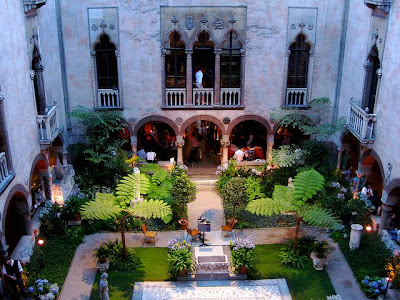EXPLORE THE BEAUTY AND INTRIGUE OF THE ISABELLA STEWART GARDNER MUSEUM WITH THEBOOKJEANIE
During the Renaissance, wealthy Venetians built magnificent stone palazzos with elegant balconies along the Grand Canal. In 1903, a unique museum opened in a quiet neighborhood off the Back Bay Fens in Boston, created by heiress Isabella Stewart Gardner in the style of the Venetian palazzos with an important difference: Gardner's palazzo was designed inside out, the exterior imposing but austere, the inside courtyard a dreamy magical space of soaring balconies, intricate stonework, and lush tropical gardens under a glass roof. Gardner spent many years passionately collecting treasured art works throughout Europe and Asia, assembling a world-class collection of over 2500 paintings, sculpture, and unique decorative items. On March 18, 1990, two thieves masquerading as Boston policemen responding to a call from the museum, entered the gallery, tied up the guards, and walked out with masterpieces valued at over $500 million, including Vermeer's The Concert, one of the most valuable paintings in the world. Almost twenty-five years later this crime still remains unsolved - none of the paintings have ever been recovered.
Investigative journalist Ulrich Boser set out to revisit the world's largest art theft and became trapped by his own obsession to solve this most elusive crime. Early into his research, Boser became the recipient of the extensive files of Harold Smith, one of the most respected art detectives in the field, who recently passed away. This massive storehouse of information led Boser to numerous witnesses, informers, police detectives, political figures and underworld crime figures, all with their own ideas of how the crime was orchestrated and where the paintings might be hidden. At one point, Boser was following the trail of notorious crime boss, Whitey Bulger, going from village to village in the remote area of Ireland where he had last been seen. With the arrest of Bulger after this book was published, it appears unlikely that he had any significant knowledge of the location of the stolen art, otherwise he would have already used this information to his legal advantage. Boser proposes certain hypotheses and provides credible evidence that support his ideas. But it is his long and arduous investigative journey as well as the characters he encounters that make this such a fascinating read. Stay tuned. . . the FBI recently released a statement claiming that they have identified the thieves, members of a crime organization in the northeast, and have been able to trace the journey of the art works although they do not know the present location of the stolen works.
It is not surprising that the Gardner heist served as the inspiration for an intriguing art thriller by B.A. Shapiro, The Art Forger. Artist Claire Roth is supporting herself as an artist by painting commissioned reproductions of mainly Impressionist works for a legitimate art firm, a perfectly legal endeavor although one that Claire is not particularly proud to have mastered. She is hoping that a new series of her original oils will establish her reputation as an artist if only she can find a dealer to display her work. Unexpectedly she receives a visit from a well-known gallery owner, Aiden Markel, who promoted her famous deceased lover and now offers her a very tempting deal: paint a reproduction of the stolen painting by Degas for him and he will return the original to the Gardner Museum with the copy going to the new "owner" of the painting. The sweetener is that Markel promises to stage a one-woman show for Claire in exchange for the forgery. Motivated by a chance at success, Claire reluctantly agrees to work for Markel but as she begins the process of reproducing a priceless Degas masterpiece (a fictious work not part of the actual Gardner collection), she begins to question the authenticity of the painting and attempts to track down the true provenence of the work in question. This fascinating look at the world of art and artists and the fine line between reproductions and forgeries will keep you glued to the page as surprise revelations and deadly threats raise the stakes of the art game that Claire wishes she had never agreed to play.
On the heels of her latest novel, The View from Penthouse B, Elinor Lipman has now shared a collection of very personal essays on her childhood, parents, growing up Jewish in a predominantly Irish neighborhood, always being labeled "nice" but able to hold many levels of aggravated feelings (Good Grudgekeeping), surviving author readings, the joys of parenting, and most importantly, on the agony of losing her 60-year-old beloved husband to a horrible disease. Lipman never fails to hone in on the humor of life, despite the circumstances, expressing what we all feel at one time or another with such droll and elegant wit. She examines the guilt but subsequent rightousness of finally saying "no" to an unwelcome invitation, the frustration of the "trepsbeiter"( a Yiddish expression meaning the perfect retort that you don't think of until you're walking away and down the stairs), the importance of properly naming characters (and children), e.g. "When Wally Lamb named a baby Tyffanie in I Know This Much is True it worked; if we hadn't already known the IQ of Tyffanie's mother, it was there for the taking." Don't miss this one.
KEEP READING. . . SEE YOU NEXT WEEK










Comments
Post a Comment